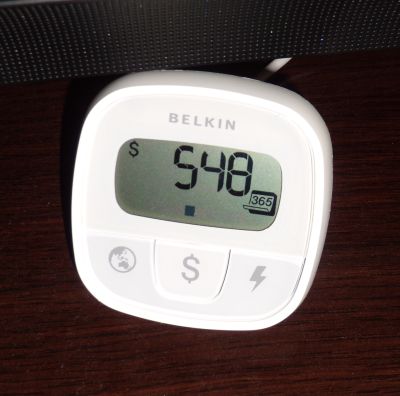Given that you cannot improve what you cannot measure I decided to purchase an inline power use monitor the power consumption of various devices around the house. The idea being that I can determine what electrical devices are using the most power during the daylight ours when our planned rooftop PV system is generating power that could potentially be put back into the grid. There’s quite a few power use devices available ranging in price from just $10 right up to several hundred dollars for professional measuring equipment. I set a budget of $50 and decided on the Belkin Conserve Insight Energy Use Monitor which happened to be $49.95 from Dick Smith Electronics. You can see the read out on the Belkin above while it’s plugged into our 50″ Plasma.
I picked this unit because of good results in several reviews I read on the cheaper units and because it has correct power factor correction calculations which is important for measuring loads into switched mode power supplies (as found in PC’s). There’s a fairly high powered PC here that is on for nearly 16 hours a day and I need to measure the power usage of it accurately.
The Belkin unit is well made and easy to use. Just plug one end into the power socket and the power cord of the device you want to measure into the other. A digital readout can give you power draw, power cost, or kilograms of CO2 being produced. Each of these can be shown as an instantaneous amount, a per month amount, or a yearly amount. I’m not quite sure how the cost of power is determined but I’ll look into that further if and when I can be bothered. The power draw is what really interests me.
As a first up test I plugged the Belkin into the smaller TV/HDD Recorder/Media Player unit we have here. It’s a 32″ LCD TV, a Panasonic HDD/DVD recorder, and a WD media player with an external HDD drive. According to the Belkin this setup draws 20W when all three devices are in standby and 100-200W while all are playing. Given that we only watch the TV for 4 hours a day that leaves 20 hours a day that it is in standby. This adds up to 146kWh per year or $36.50 potential savings by turning off the three units properly when not in use rather than leaving them in standby. I’m looking forward to using the Belkin on some other devices around the house over the coming weeks. Stay tuned for me.

